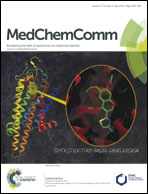Multitarget-directed resveratrol derivatives: anti-cholinesterases, anti-β-amyloid aggregation and monoamine oxidase inhibition properties against Alzheimer's disease†
Abstract
Considering the complex pathogenesis factors of Alzheimer's disease (AD), the multitarget-directed ligand strategy is expected to provide superior effects to fight AD, instead of the classic one-drug-one-target strategy. Resveratrol, exhibiting important properties against AD, was suggested to be used as a starting compound for the treatment of AD. Based on these reasons, a series of resveratrol derivatives were designed, synthesized and biologically evaluated. Among them, compound 6r, exhibiting moderate cholinesterase inhibition activity (AChE, IC50 = 6.55 μM; BuChE, IC50 = 8.04 μM; SI = 1.23), significant inhibition of Aβ42 aggregation (57.78%, at 20 μM) and acceptable inhibitory activity against monoamine oxidases (MAO-A, IC50 = 17.58 μM; MAO-B, IC50 = 12.19 μM), was a potential anti-Alzheimer agent with balanced activities. Consequently, this study provided useful information for further development of resveratrol derivatives as multitarget-directed agents for AD therapy.


 Please wait while we load your content...
Please wait while we load your content...